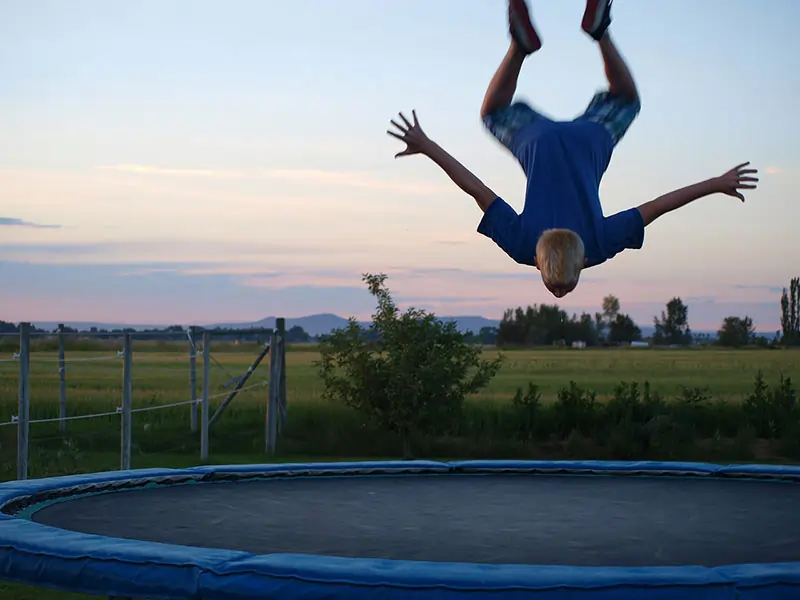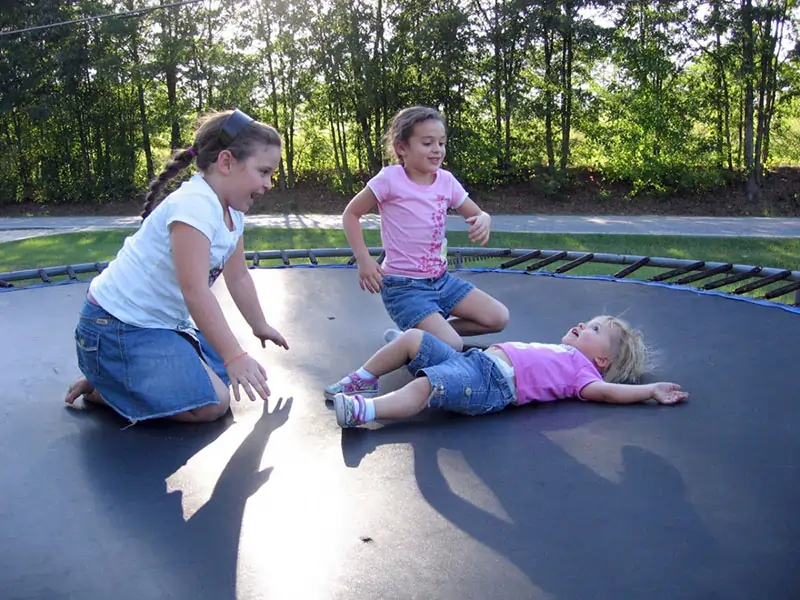How to Choose the Right Trampoline for Kids & More

Choosing a trampoline for kids has become quite a frightening but exciting task. With so many options, it is in reality a challenge to choose one that ensures both safety and durability as well as suitability to your family needs.
Trampolines provide children with hours of fun and a chance to be outdoors and engage in some form of physical activity. With the many varieties available, from the classic spring-type to the new spring-free designs and even water trampolines, selecting the right one requires careful consideration.
1. Understand the Different Types of Trampolines
There are various types of trampolines, each of which has features and considerations towards safety and performance. Traditional trampolines utilize metal springs for bounce, while spring-free models are based on flexible rods or elastic bands under the jumping surface. Water trampolines are made especially for aquatic environments and provide a really different bouncing experience with lakes or large pools.
Between the types, safety should be the consideration in picking which one to install. Traditional spring trampolines have been known to cause injury from pinching between or falling into the springs. The spring-free model is much less prone to these risks but costs more. Water trampolines, though very enjoyable for summer fun, require specific considerations in terms of anchoring and use over a water body.
What type of trampoline do you want?
Safety preferences and budget will greatly depend on your decision on which type of trampoline to choose. The traditional type is relatively inexpensive, but the maintenance of springs and padding is demanding. The spring-free type of trampoline offered by companies Springfree and Vuly lets you avoid spring-related injuries and perhaps has advanced safety features such as enclosure nets and impact-absorbing mats.
A water trampoline, in such families, introduces a unique type of recreation that combines the enjoyment of bouncing with the refreshing factor of being on the water. This type of trampoline is equipped with buoyant materials and safety features to provide stability and prevent accidents in the water environment.
2. Determine the Right Size: What Size of Trampoline Do You Need?
The size is one of the criteria for choosing a trampoline: it determines exactly how much area your backyard will consume and how many children can safely jump on it at once.
The size of the trampoline should be proportional to the free space within your yard. Measure the location where you intend to place the trampoline and make sure there is enough free space around it to have easy access as well as enough space in which children can bounce freely without risking collision either with one another or with the enclosure net.
For tighter spaces, a compact trampoline with diameters from 8 to 10 feet will give ample jumping room without taking up much space. Larger yards allow bigger trampolines up to 15 feet in diameter which will better accommodate families with more children or older kids who can jump for longer stretches.
Backyard Space
Ensure you make proper space measurements in your yard for the maximum dimensions that will comfortably fit without clobbering the space. Leave at least 2 feet of clearance around the trampoline so as to not compromise safety or access in use.
Observe your yard configuration, thinking of the conditions that could interfere with its location such as trees, fences, and gardens. Make sure there is no possible overhead blocking, like branches or electric lines, that could be dangerous when you jump.
Kid’s Age and Future Growth
Thus, considerations may be taken to include your kids’ ages and sizes as well as potential growth in the coming years. Too small a trampoline may become an infringement on movement with less enjoyable play, whereas too large a trampoline might be intimidating or a safety hazard in case it cannot reach the mat comfortably.
A better option is a trampoline that can support the combined weight of all its potential users for safe and fun bouncing. Other models with adjustable height settings or add-on accessories, such as handlebars or safety nets, can also increase support and confidence.
Trampoline Weight Limit
The first thing to do is check the weight limit recommendation by the manufacturer for the trampoline to ensure that it can safely take the users who will be jumping. Be careful about weight distribution, and make sure that all safety precautions, such as an enclosure net and padding, are in place and maintained.
Jumping Room
The jumping surface diameter should, therefore be checked to ensure there is enough jumping space for safe bouncing and tricks without overcrowding. The second aspect is the height of the enclosure net which ensures users will not bounce out over the edge.
Trampoline Shape
Trampolines come in different shapes. There are round, rectangular, and oval trampolines, which have their particular bounce dynamics and space utilization benefits.
Round trampolines are the most popular, as they give an evenly spread out bounce all around the surface; thus it is suitable for less mature children and just playing. Rectangular trampolines provide more bounce and are very popular among gymnasts and athletes for training tricks and other exercises. Oval models combine all the good things about round and rectangular trampolines, offering greater jumping area with relatively equal bouncing.
Depending on which shape you decide for your new trampoline, take a look at the layout of your yard to decide where the trampoline will fit in that space. See here: (https://www.kidsafensw.org/imagesDB/documents/Trampolines2020_2.pdf). Generally speaking, round trampolines are easier to place in a smaller yard when compared with rectangular or oval models that require a bit more effort to be sure it fits well in the available space while keeping safety paramount.
3. Evaluate Safety Features
Safety has to be the first concern when choosing a trampoline for kids. Look for variants with advanced safety measures, which will help keep them from accidents and injuries on the trampoline.
What safety and quality features are required for trampolines?
Your trampoline must meet or exceed the safety standards given by organizations such as ASTM International. It should comprise features such as a firm frame, UV-resistant padding, and high-quality enclosure nets in the pursuit of reducing risks involving falls and impact.
Spring-free models avoid all the risks of spring injuries; they may employ flexible rods or elastic bands under the jumping surface. Models also possess safety features apart from the soft-edge technology, and impact-absorbing mat that will absorb land and will make the users of the spring-free trampoline safe.
Look for the right shape (seen here), but also check for safety certifications and reviews to have an idea of its reliability and performance in practice by other people. Some accessories provided include ladder attachments, anchor kits, and weather covers that add safety and extend the life of the trampoline.

4. Assess Durability and Longevity
Spend your money on a well-designed trampoline, preferably one with strong material that will last out there in the weather and all the bouncing you are likely to do. Trampolines may come with weather-resistant coating and rust-resistant components that help maintain durability and minimize frequent maintenance.
How long do you want the trampoline to last?
Thus, when choosing the right trampoline for your family, balance the price that you will pay upfront against the durability needed in the long run. Above everything else, look for a model with a good warranty and responsive customer support that will enable you to call for assistance during any problem or concern that you may experience after a long period of time.
Spring-free trampolines also typically include full warranties on the frame and mat components, so you should have trouble-free long-term performance. Compare the warranty coverage with customer reviews to make your decision based on the reputation and reliability of the manufacturing company.
5. Consider Trampoline Accessories
It is worth considering other options and add-ons available when choosing a trampoline for your kids, as these may mean all the difference in terms of functionality and overall fun of your trampoline. These accessories, above the bouncing game alone, give more ways to play, more safety, and convenience. Here is a review of some of the trampoline models that gained popularity for their added accessories:
Enclosure Nets
Protecting the jumping areas in trampolines are done by enclosure nets. These are made of mesh material with high strength supported by very strong poles. When purchasing your trampoline, ensure the enclosure net fits well and can securely protect your children at the required heights, and is capable of withstanding any impact forcefully produced. More advanced trampolines have entrance designs which overlap and have a self-closing mechanism to add protection.
Ladder Attachments
Attachments have steps with non-slip bases that provide safety for climbers. They also ensure solid building as their tests confirm. Other trampolines are ready with ladder attachments that are attached to the frame, and they clip very well onto it, giving the users easy access without making the trampoline unstable. Always consider the height and weight capacity of the attachment to ensure that all users can safely get on and off.
Anchor Kits
These are pieces with attachments that fasten into the ground to hold the trampoline firmly in place, ascertaining safety for its users. Anchors come in a self-drilling kit suitable for harder grounds and a soft spike kit, convenient for softer grounds.
It is essential to anchor kits so that your trampoline is well secured on the ground, more so during adverse conditions, such as a windy or rainy day. Generally, it has strong stakes or augers that secure the trampoline’s frame to the ground; hence, it will not tip over or shift due to use. An anchor kit is supposed to be used with all outdoor trampolines for safety and stability, especially in an area prone to very powerful winds or uneven terrain.
Weather Covers
The cover protects your trampoline from unwanted elements in the weather, such as rain and snow, thus making it have a longer lifespan and easier to keep clean. Covers are normally made of strong, weather-resistant materials that will fit snugly over the frame and jumping mat of the trampoline. Some are even covered with UV protection to prevent fading and wear from long periods of sun exposure. If unused, be sure to secure the cover tightly so that it does not blow away in windy weather.
Basketball Hoops and Games
Appending basketball hoops and other interactivity games can turn the trampoline from something that is just a playground to something more. In fact, attachable basketball hoops are generally popular because kids like practicing shooting baskets while bouncing on the trampoline.
Hoops with soft rims and soft basketballs in case that will prevent injury and safe playing during the session. Other games such as, in addition, to toss and catch accessories, Velcro target pads, and ball games develop active play together with coordination skills in the bouncing experience.
Tents and Canopies
Tents and canopies provide shaded spaces above the trampoline, protect the kids from direct sunlight, and let them easily play outdoors. These are particularly helpful during hot summer days when you would want your little ones to bounce about and frolic in the shade. Search for tents and canopies constructed using UV-resistant materials and convenient assembly for proper locking into the trampoline’s frame. Some of them even come with zippered doors and windows to ventilate the area.
6. Set Your Budget
Set an affordable budget in advance based on your priorities regarding safety, quality, and durability of a trampoline for your family. Be sure to consider all the cost-of-ownership factors, including those optional accessories, maintenance, and replacement parts, to ensure that you get value from your spending.
How much are you willing to spend?
Consider the installation, maintenance, and replacement parts expenses of the trampoline. Compare price ranges from various brands and models so that you can have a budget-friendly trampoline that doesn’t compromise on safety or quality.

Frequently Asked Questions (FAQs)
Are outdoor trampolines safe for kids?
Safety for kids when using outdoor trampolines can be nearly perfect, of course, should it be used in the proper manner, fitted with an enclosure net, padding, and adult supervision. But to minimize all risks while these kids are bouncing, read manufacturer guidelines for installation, maintenance, and use.
What’s the best or safest trampoline for kids?
The best trampoline for kids depends on your family’s preferences for size, type, and safety features. To find the best trampolines in Australia, consider factors such as spring-free designs, enclosure nets, and durable materials when selecting a trampoline that meets your needs and provides a safe and enjoyable outdoor play experience for children. It’s important that everyone is both safe and happy.
What is the price of the trampoline?
When it comes to pricing, trampolines vary in size, type, brand, and also safety enclosures as well as weather-resistant materials. Budget-friendly trampolines start at around $200 for smaller models while good premium trampolines without springs start at about $1,000 or more for very high-quality made trampolines. Compare prices and choose your family’s needs considering your budget and your priorities of safety and quality.
Conclusion: Which Trampoline Is Right for Your Family?
You may want to pick the best trampoline for your family by considering a trampoline type, size, safety features, durability, and budget. Conducting thorough research can help you make the right choices in purchasing the best trampoline based on thorough customer reviews and comparisons of different products from different brands.
Safety features such as netting for enclosures, impact-absorbing mats, and durable construction materials are reasons to invest in a trampoline. The size of your backyard, the ages and sizes of your children, and their interests in bouncing and physical exercise should be the other factors while making your decision for a trampoline, either a traditional spring-based one or a modern spring-free design. I will prioritize the one that comes with top quality and reliability to ensure long-term satisfaction and minimal maintenance.
Remember to assemble it correctly, look after it properly, and use it safely according to the manufacturer’s guidelines. This would enable your trampoline to last longer and maximize the safety it must impart to its users. Thoughtful and careful in your choices, you can make the right decision with a trampoline that will be cherished by your backyard as this might evoke lively play and create lifelong memories with your family.
A good trampoline shows a balance of safety, durability, and enjoyment. Outwardly, it shows the benefits of physical activity and outdoor fun. Meanwhile, by putting more emphasis on safety features, the suitable size, and type that best meets your needs, and with a budget that you set, aligning with your priorities, you will surely choose a trampoline that will enhance your family’s outdoor experience and encourage a healthy and active lifestyle for years to come.


